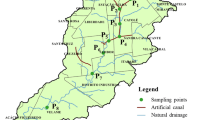Abstract
Drinking water supply organization in Tehran has 24 chlorination stations. These are located randomly between houses across the city. Tehran is a crowded city with high density of population, 11,360.9 persons in every km2. There are a large number of people at risk if chlorine gas is accidentally released in these stations. The aim of study was evaluation of chlorine gas release hazard in the chlorination stations. To achieve this goal, FTA, a popular safety analysis method, was used. The identified basic events (BE)—a total of 1,224—were categorized into four groups: human errors (HE), management oversights (MO), design errors (DE), and hardware failures (HF). Distribution of BEs in these groups showed that the highest percent of them were in the HE group (43.5%), 31.6 % in the MO, 24.1% in the DE, and 0.8 % in the HF group. Qualitative analysis on the fault tree yielded a total of 2,083 Minimal Cut Sets. The probability of chlorine gas being accidentally released in the stations varied from 10 to 21/year. In chlorinator room this probability was 1.43 times higher than in the cylinder room. In prevention of a chlorine gas release accident, lack of training has a very important role and the design of stations is more important than the design of the equipment.

Similar content being viewed by others
References
Mustapha S., Hee T.C., El-Harbawi M., Shariff A.R., Choong T.S.Y., Zakariaz A.Z., Mispan R.: Chlorine incident and its toxic hazardous chemical release impact in the area surrounding a swimming-pool using GIS. Disaster Prev. Manag. 13(5), 387–398 (2004)
Austin, A.K.: Preventing chlorine gas accidents. Occup. Health Saf. 74(5), 48, 50, 52 (2005)
Bommaraju, T.V., Luke, B., O’Brien, T.F., et al.: In: Kirk-Othmer Encyclopedia of Chemical Technology: Chlorine, vol. 6. Wiley, London (2004)
Molavi, A.: Evaluation of chlorine in chlor-alkali manufacturing plant. MSPH thesis, Tarbiyat Modarres University, Tehran, Iran (2001)
Pamphlet 1: Chlorine Basics (formerly The Chlorine Manual). The Chlorine Institutes Online Book Store. http://www.chlorineinstitute.org/Bookstore/content.cfm?ItemNumber=3637&navItemNumber=3638 (2008)
Sanaei G.H.: Industrial Toxicology, 2nd edn. Tehran University Publications, Tehran (1996)
Bingham, E., Cohrssen, B., Powell, C.H. (eds): Patty’s Toxicology, vol. 3. Wiley, New York (2001)
ACGIH. Chlorine: Documentation of the Threshold Limit Values for Chemical Substances. American Conference of Governmental Industrial Hygienist, Cincinnati (2001)
Pamphlet 155: Water and Wastewater Operators. In: Chlorine Handbook: Recommendations for Prevention of Personnel Injuries for Chlorine, Production and Use Facilities. The Chlorine Institutes Online Book Store. http://www.chlorineinstitute.org/Bookstore/content.cfm?ItemNumber=3637&navItemNumber=3638 (2008)
National Primary Drinking Water Regulations. US Environmental Protection Agency, Office of Ground Water and Drinking Water, EPA, Washington, DC:EPA816F03016. http://www.epa.gov/safewater/mcl.html (2003)
Guidelines for Drinking Water Quality, vol. 1, 3rd edn. Recommendations. World Health Organization, Geneva. http://www.who.int/water_sanitation_health/dwq/gdwq3/en/ (2004)
Edition of Drinking Water Standards and Health Advisories. US Environmental Protection Agency. EPA, Washington, DC: EPA822R04005. http://epa.gov/watercience/criteria/drinking/ (2006)
None published records: Annual Report. Drinking Water Organization, Tehran, Iran (1999)
DPC Enterprises Chlorine Release-Investigation Information. US Chemical Safety and Hazard Investigation Board. http://www.chemsafety.gov/index.cfm (2003)
Official Reports. The Statistical Center of Iran, Tehran. http://www.sci.org.ir (2007)
AIHA. Chlorine: Emergency Response Planning Guidelines (ERPG). American Industrial Hygiene Association, Fairfax (2004)
Strong bleach agent. http://www.powelfab.com/technicalinformation/sodium_hypochlorite/how_made.asp
Kirwan, B., Scannali, S., Robinson, L.: A Case Study of a Human Reliability Assessment for An Existing Nuclear Power Plant. Appl. Ergon. 15677070(P, S, E, B), Oct 7, 289–302 (1996)
Vesely, W.E., Goldberg, F.F., Roberts, N.H., Haasl, D.F.: Fault Tree Handbook. US Nuclear Regulatory Commission, NUREG-0492, 1981, X1–X7 (1981)
Enriquez P.: Failure Analysis of the PSTN. Mills College Oakland, California (Mentors: Aaron Brown David Patterson). http://www.docstoc.com/docs/2365501/Failure-Analysis-of-the-PSTN-2000 (2000)
Brazier, A., Richardson, P., Embereym, D.: Final report—human factor assessment of safety critical tasks. Human Reliability Associate (2000)
Feyer A.-M., Williamson A.M., Cairns D.R.: The involvement of human behavior in occupational accident: error in context. Saf. Sci. 25(1–3), 55–65 (1997)
Carayon, P., Gurses, A.P.: Nursing workload and patient safety—a human factors engineering perspective. In: Patient Safety and Quality: An evidence-based handbook for nurses, vol. 2, chap. 30. AHRQ Publication No. 08-0043. http://www.ncbi.nlm.nih.gov/bookshelf/br.fcgi?book=nursehb&part=ch30 (2008)
Grasha A.F., Schell K.: Psychosocial factors, workload, and human error in a simulated pharmacy task. Percept. Mot. Skills 92, 53–71 (2001)
Grasha, A.F.: Workload and pharmacy dispensing errors. In: Cognitive-System Lab. Research Update, vol. 1(2), 1–15. Department of Psychology, University of Cincinnati, Cincinnati, OH (1998)
Grasha, A.F., O’ Neill, M.: Cognitive process in medication errors. US Pharm. June, 96–109 (1996)
Kistner U.A., Keith M.R., Seargeant K.A., Hokanson J.A.: Comparison of two modes of stress management: daily hassles versus major life events. J. Behav. Med. 4, 1–26 (1994)
Scherer, R.F., Petrick, J.A., Quinn, J.F.: Sources of injury: occupational safety trends. Rev. Bus. 18 (1996)
Mohammadfam, I.: Evaluation of electro filter’s explosion in Tehran cement Company. MSPH thesis, Tarbiyat Modarres University, Tehran, Iran (1998)
Author information
Authors and Affiliations
Corresponding author
Rights and permissions
About this article
Cite this article
Adl, J., Nezamoddini, Z. Evaluation of Chlorine Gas Release Hazard. Arab J Sci Eng 37, 1–8 (2012). https://doi.org/10.1007/s13369-011-0161-6
Received:
Accepted:
Published:
Issue Date:
DOI: https://doi.org/10.1007/s13369-011-0161-6




